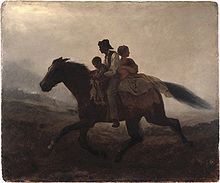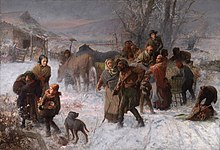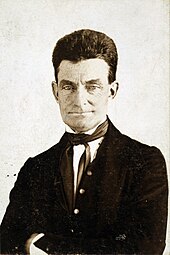BLACK SOCIAL HISTORY Underground Railroad
This is the 19th-century slave escape routes. For railroads built below ground, see rapid transit. For the band, see Underground Railroad
| Slavery |
|---|
 |
The Underground Railroad was a network of secret routes and safe houses used by 19th-century slaves of African descent in the United States to escape to free states and Canada with the aid of abolitionists and allies who were sympathetic to their cause.[1] The term is also applied to the abolitionists, both black and white, free and enslaved, who aided the fugitives.[2] Various other routes led toMexico or overseas.[3] An "Underground Railroad" running south toward Florida, then a Spanish possession, existed from the late 17th century until shortly after the American Revolution.[4] But, the network now generally known as the Underground Railroad was formed in the early 19th century, and reached its height between 1850 and 1860.[5] One estimate suggests that by 1850, 100,000 slaves had escaped via the "Railroad".[5]
British North America (present-day Canada), where slavery was prohibited, was a popular destination, as its long border gave many points of access. Most former slaves settled in Ontario. More than 30,000 people were said to have escaped there via the network during its 20-year peak period,[6] although U.S. Census figures account for only 6,000.[7] Numerous fugitives' stories are documented in the 1872 book The Underground Railroad Records by William Still, an abolitionist operating in Philadelphia.
Political background
Even at the height of the Underground Railroad, fewer than 1,000 slaves per year, from all slave-holding states, were able to escape (just over 5,000 court cases for escaped slaves were recorded), many fewer than the natural increase of the enslaved population. Although the economic impact of such escapes was small, the psychological influence on slaveholders of an informal network to assist escaped slaves was immense. Under the original Fugitive Slave Law of 1793, officials of the states from which the slaves came had responsibility to try to recover them. Citizens and governments of many free states ignored the law, and the Underground Railroad thrived.
With heavy political lobbying by the South, the Compromise of 1850, passed by Congress after the Mexican-American War, stipulated a more stringent Fugitive Slave Law. Ostensibly, the compromise addressed all regional problems. However, it compelled officials of free states to assist slave catchers if there were runaway slaves in the area, and granted slave catchers immunity, when in free states, to do their job.[8]Because it required little documentation to claim a person was a fugitive slave, slave catchers also kidnapped free blacks and sold them into slavery, especially children.[9] The law deprived suspected slaves of the right to defend themselves in court, and it was difficult to prove free status. In a de facto bribe,[10] judges were paid a higher fee ($10) for a decision that confirmed a suspect as a slave than for one ruling that the suspect was free ($5). Many Northerners who might have ignored slave issues in the South were confronted by local challenges that bound them to support slavery. This was a primary grievance cited by the Union cause in the Civil War,[11] and the perception that Northern States were ignoring the fugitive slave law was a major justification for secession.[12]
Structure
See also: Vigilance committee
The escape network was not literally underground nor a railroad. It was figuratively "underground" in the sense of being an underground resistance. It was known as a "railroad" by way of the use of rail terminology in the code.[14] The Underground Railroad consisted of meeting points, secret routes, transportation, and safe houses, and personal assistance provided by abolitionist sympathizers. Participants generally organized in small, independent groups; this helped to maintain secrecy because individuals knew some connecting "stations" along the route but knew few details of their immediate area. Escaped slaves would move north along the route from one way station to the next. "Conductors" on the railroad came from various backgrounds and included free-born blacks, white abolitionists, former slaves (either escaped or manumitted), and Native Americans. Church clergy and congregations often played a role, especially theReligious Society of Friends (Quakers), Congregationalists, Wesleyans, and Reformed Presbyterians as well as certain sects of mainstream denominations such as branches of the Methodist church and American Baptists. Without the presence and support of free black residents, there would have been almost no chance for fugitive slaves to pass into freedom unmolested.[15]
Route
To reduce the risk of infiltration, many people associated with the Underground Railroad knew only their part of the operation and not of the whole scheme. "Conductors" led or transported the fugitives from station to station. A conductor sometimes pretended to be a slave in order to enter a plantation. Once a part of a plantation, the conductor would direct the runaways to the North. Slaves traveled at night, about 10–20 miles (15–30 km) to each station. They would stop at the so-called "stations" or "depots" during the day and rest. The stations were often located in barns, under church floors, or in hiding places in caves and hollowed-out riverbanks. While the fugitives rested at one station, a message was sent to the next station to let the station master know the runaways were on their way.
The resting spots where the runaways could sleep and eat were given the code names "stations" and "depots," which were held by "station masters". "Stockholders" gave money or supplies for assistance. Using biblical references, fugitives referred to Canada as the "Promised Land" and the Ohio River as the "River Jordan", which marked the boundary between slave states and free states.[16]
Traveling conditions[edit]
Although the fugitives sometimes traveled on boat or train,[18] they usually traveled on foot or by wagon in groups of 1–3 slaves. Some groups were considerably larger. Abolitionist Charles Turner Torrey and his colleagues rented horses and wagons and often transported as many as 15 or 20 slaves at a time.[19]
Routes were often purposely indirect to confuse pursuers. Most escapes were by individuals or small groups; occasionally, there were mass escapes, such as with the Pearl incident. The journey was often considered particularly difficult and dangerous for women or children, yet many still participated. One of the most famous and successful abductors (people who secretly traveled into slave states to rescue those seeking freedom) wasHarriet Tubman, an escaped slave woman.[20]
Due to the risk of discovery, information about routes and safe havens was passed along by word of mouth. Southern newspapers of the day were often filled with pages of notices soliciting information about escaped slaves and offering sizable rewards for their capture and return.Federal marshals and professional bounty hunters known as slave catchers pursued fugitives as far as the Canadian border.[21]
Fugitives were not the only black people at risk from slavecatchers. With demand for slaves high in the Deep South as cotton was developed, strong, healthy blacks in their prime working and reproductive years were seen and treated as highly valuable commodities. Both former slaves and free blacks were sometimes kidnapped and sold into slavery, as was Solomon Northup of Saratoga Springs, New York. "Certificates of freedom," signed, notarized statements attesting to the free status of individual blacks also known as free papers, could easily be destroyed or stolen, so provided little protection to bearers.
Some buildings, such as the Crenshaw House in far southeastern Illinois, are known sites where free blacks were sold into slavery, known as the "Reverse Underground Railroad". Under the terms of the Fugitive Slave Act of 1850, when suspected fugitives were seized and brought to a special magistrate known as a commissioner, they had no right to a jury trial and could not testify in their own behalf. Technically, they were guilty of no crime. The marshal or private slave-catcher needed only to swear an oath to acquire a writ of replevinfor the return of property.
Congress was dominated by southern Congressmen, as apportionment was based on three-fifths of the number of slaves being counted in population totals. They passed the Fugitive Slave Law of 1850 because of frustration at having fugitive slaves helped by the public and even official institutions outside the South. In some parts of the North, slave-catchers needed police protection to exercise their federal authority. Opposition to slavery did not mean that all states welcomed free blacks. For instance, Indiana, whose area along the Ohio River was settled by Southerners, passed a constitutional amendment that barred free blacks from settling in that state.
Terminology
Members of the Underground Railroad often used specific terms, based on the metaphor of the railway. For example:
- People who helped slaves find the railroad were "agents" (or "shepherds")
- Guides were known as "conductors"
- Hiding places were "stations"
- "Station masters" hid slaves in their homes
- Escaped slaves were referred to as "passengers" or "cargo"
- Slaves would obtain a "ticket"
- Similar to common gospel lore, the "wheels would keep on turning"
- Financial benefactors of the Railroad were known as "stockholders".[22]
The Big Dipper (whose "bowl" points to the North Star) was known as the drinkin' gourd. The Railroad was often known as the "freedom train" or "Gospel train", which headed towards "Heaven" or "the Promised Land", i.e., Canada.
William Still,[23] often called "The Father of the Underground Railroad", helped hundreds of slaves to escape (as many as 60 a month), sometimes hiding them in his Philadelphia home. He kept careful records, including short biographies of the people, that contained frequent railway metaphors. He maintained correspondence with many of them, often acting as a middleman in communications between escaped slaves and those left behind. He published these accounts in the book The Underground Railroad (1872), a valuable resource for historians to understand how the system worked and a recounting of individual ingenuity in escapes.
According to Still, messages were often encoded so that they could be understood only by those active in the railroad. For example, the following message, "I have sent via at two o'clock four large hams and two small hams", indicated that four adults and two children were sent by train from Harrisburg to Philadelphia. The additional word via indicated that the "passengers" were not sent on the usual train, but rather via Reading, Pennsylvania. In this case, the authorities were tricked into going to the regular train station in an attempt to intercept the runaways, while Still met them at the correct station and guided them to safety. They eventually escaped either to the North or to Canada, where slavery had been abolished during the 1830s.
Folklore
Since the 1980s, claims have arisen that quilt designs were used to signal and direct slaves to escape routes and assistance. According to advocates of the quilt theory, ten quilt patterns were used to direct slaves to take particular actions. The quilts were placed one at a time on a fence as a means of nonverbal communication to alert escaping slaves. The code had a dual meaning: first to signal slaves to prepare to escape, and second to give clues and indicate directions on the journey.[24]
The quilt design theory is disputed. The first published work documenting an oral history source was in 1999, and the first publication of this theory is believed to be a 1980 children's book.[25] Quilt historians and scholars of pre-Civil-War America have disputed this legend.[citation needed] There is no contemporary evidence of any sort of quilt code, and quilt historians such as Pat Cummings and Barbara Brackman have raised serious questions about the idea. In addition, Underground Railroad historian Giles Wright has published a pamphlet debunking the quilt Songs of the Underground Railroad
Similarly, some popular, nonacademic sources claim that spirituals and other songs, such as "Steal Away" or "Follow the Drinking Gourd", contained coded information and helped individuals navigate the railroad. They have offered little evidence to support their claims. Scholars tend to believe that while the slave songs may certainly have expressed hope for deliverance from the sorrows of this world, these songs did not present literal help for runaway slaves.[26]
The Underground Railroad inspired cultural works. For example, a song written in 1860 about a man fleeing slavery in Tennessee by escaping to Canada, entitled "Song of the Free", was composed to the tune of "Oh! Susanna." Every stanza ends with a reference to Canada as the land "where colored men are free". Slavery in Canada had been in rapid decline after an 1803 court ruling, and abolished outright in 1834.
Legal and political
When frictions between North and South culminated in the American Civil War, many blacks, slave and free, fought for the Union Army.[27] Following Union victory in the Civil War, on December 6, 1865, Congress passed the Thirteenth Amendment to the Constitution which outlawed slavery.[28] Following its passage, in some cases the Underground Railroad operated in reverse, as fugitives returned to the United States.[29]
Criticism
Frederick Douglass, writer, statesman, and an escaped slave, wrote critically of the Underground Railroad in his seminal autobiography:
He went on to say that, although he honors the movement, he feels that the efforts serve more to enlighten the slave-owners than the slaves, making them more watchful and making it more difficult for future slaves to escape.[30]
Arrival in Canada
Estimates vary widely, but at least 30,000 slaves, and potentially more than 100,000, escaped to Canada via the Underground Railroad.[6] The largest group settled in Upper Canada (Ontario) called Canada West from 1841.[31] Numerous Black Canadian communities developed in Southern Ontario. These were generally in the triangular region bounded by Toronto, Niagara Falls, and Windsor. Nearly 1,000 refugees settled in Toronto, and several rural villages made up mostly of ex-slaves were established in Kent and Essex counties.
Another important center of population was Nova Scotia, for example Africville and other villages near Halifax, see Black Nova Scotians. Many of these settlements were started by Black Loyalists after the American Revolutionary War. Important black settlements also developed in other parts of British North America (now parts of Canada). These included Lower Canada (present-day Quebec) and Vancouver Island, where GovernorJames Douglas encouraged black immigration because of his opposition to slavery. He also hoped a significant black community would form a bulwark against those who wished to unite the island with the United States.
Upon arriving at their destinations, many fugitives were disappointed as life in Canada was difficult. While the British colonies had no slavery after 1834, discrimination was still common. Many of the new arrivals had to compete with mass European immigration for jobs, and overt racism was common. For example, in reaction to Black Loyalists being settled in eastern Canada by the Crown, the city of Saint John, New Brunswick amended its charter in 1785 specifically to exclude blacks from practicing a trade, selling goods, fishing in the harbour, or becoming freemen; these provisions stood until 1870.[32]
With the outbreak of the Civil War in the U. S., many black refugees left Canada to enlist in the Union Army. While some later returned to Canada, many remained in the United States. Thousands of others returned to the American South after the war ended. The desire to reconnect with friends and family was strong, and most were hopeful about the changes emancipation and Reconstruction would bring.

























































































































































































































No comments:
Post a Comment